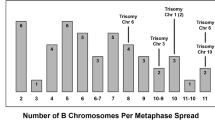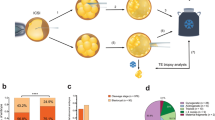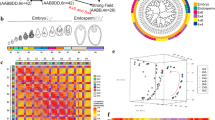Summary
The tri gene has a unique effect on barley meiosis. It suppresses second division in about 50 per cent of embryo sac mother cells (emc's) at random so that diploid embryo sacs are formed. Otherwise, meiosis is regular in all emc's and female fertility is normal in all spikes. However, tri does not similarly affect pollen mother cells (pmc's). Meiosis is regular in over 80 per cent of pmc's and fertility on selling is normal. A maximum of only 1.2 per cent of pmc's and pollen grains have a doubled chromosome number, but extra chromosomes occur in 0–20 per cent (mean 10 per cent) of pmc's, probably through spindle abnormalities at the last premeiotic mitosis.
The tri gene has cytogenetic potential for aneuploid and polyploid production and centromere mapping. If it occurs in the wild, it may play a significant role in Hordeum evolution.
Similar content being viewed by others
Article PDF
References
Ahokas, H. 1977. A mutant of barley: triploid inducer. Barley Genet Newsl, 7, 4–6.
Beatty, R A. 1978. The origin of human triploidy: an integration of qualitative and quantitative evidence. Ann Hum Genet, 41, 299–314.
Bělař, K. 1923. Über den Chromosomenzyklus von parthenogenetischen Erdnematoden. Biol Zbl, 43, 513–518.
Bennett, M D, and Smith, J B. 1976. Nuclear DNA amounts in angiosperms. Phil Trans R Soc Ser B, 274, 227–274.
Bremer, G. 1949. Increase of chromosome numbers in species hybrids of Saccharum. Proc. 8th Int. Cong. Genet. pp. 541–542. Hereditas Suppl.
Darlington, C D. 1965. Cytology. J. and A. Churchill, London.
Dowrick, G J. 1953. The chromosomes of Chrysanthemum. III. Meiosis in C. atratum. Heredity, 7, 219–226.
Harlan, J R, and De Wet, J M J. 1975. On Ö. Winge and a prayer: the origins of polyploidy. Bat Rev, 41, 361–390.
Jensen, C J. 1976. Barley monoploids and doubled monoploids: techniques and experience. In Barley Genetics III, ed. H. Gaul, pp. 316–345. Karl Thiemig, München.
Lewis, K R, and John, B. 1963. Chromosome Marker. J. and A. Churchill, London.
Ramanna, M S, and Mutsaerts, M C A. 1971. Unusual behaviour of growing pollen tubes in the styles and ovules of Spinacia oleracea L. Euphytica, 20, 145–151.
Rhoades, M M, and Dempsey, E. 1966. Induction of chromosome doubling at meiosis by the elongate gene in maize. Genetics, 54, 505–522.
Ross, H, and Langton, F A. 1974. Origin of unreduced embryo sacs in diploid potatoes. Nature, 247, 378–379.
Sadasivaiah, R S, and Kasha, K J. 1971. Meiosis in haploid barley—an interpretation of non-homologous chromosome associations. Chromosoma, 35, 247–263.
Sosa, R, and Hernández De Sosa, M. 1971. Use of dihaploids in the breeding of Solanum tuberosum L. Hereditas, 69, 83–100.
Subrahmanyam, N C. 1976. Interspecific hybridization, chromosome elimination and haploidy in Hordeum. Barley Genet Newsl, 6, 69–70.
Subrahmanyam, N C. 1977. Haploidy from Hordeum interspecific crosses. I. Polyhaploids of H. parodii and H. procerum. Theor Appl Genet, 49, 209–217.
Subrahmanyam, N C, and Kasha, K J. 1973. Selective chromosomal elimination during haploid formation in barley following interspecific hybridization. Chromosoma, 42, 111–125.
Swanson, C P. 1958. Cytology and Cytogenetics. MacMillan, London.
Taylor, L M. 1978. Variation patterns of parthenogenetic plants derived from “unreduced” embryo sacs of Solanum tuberosum subspecies andigena (Juz. et Buk.) Hawkes. Theor Appl Genet, 52, 241–249.
Tsuchiya, T. 1964. Chromosome aberrations and their use in genetics and breeding in barley—trisomics and aneuploids. In Barley Genetics I, eds. S. Broekhuizen, G. Dantuma, H. Lamberts and W. Lange, pp. 116–150. Centre for Agricultural Publications and Documentation, Wageningen.
Wagenaar, E B. 1968. Meiotic restitution and the origin of polyploidy. II. Prolonged duration of metaphase I as causal factor of restitution induction. Can J Genet Cytol, 10, 844–852.
Author information
Authors and Affiliations
Rights and permissions
About this article
Cite this article
Finch, R., Bennett, M. Action of triploid inducer (tri) on meiosis in barley (Hordeum vulgare L.). Heredity 43, 87–93 (1979). https://doi.org/10.1038/hdy.1979.62
Received:
Issue date:
DOI: https://doi.org/10.1038/hdy.1979.62
This article is cited by
-
Apomixis: A Foresight from Genetic Mechanisms to Molecular Perspectives
The Botanical Review (2022)
-
Advances and perspectives in the generation of polyploid plant species
Euphytica (2016)
-
Meiosis, unreduced gametes, and parthenogenesis: implications for engineering clonal seed formation in crops
Plant Reproduction (2015)
-
Gamete formation without meiosis in Arabidopsis
Nature (2008)
-
The transfer of a powdery mildew resistance gene from Hordeum bulbosum L to barley (H. vulgare L.) chromosome 2 (2I)
Theoretical and Applied Genetics (1995)



